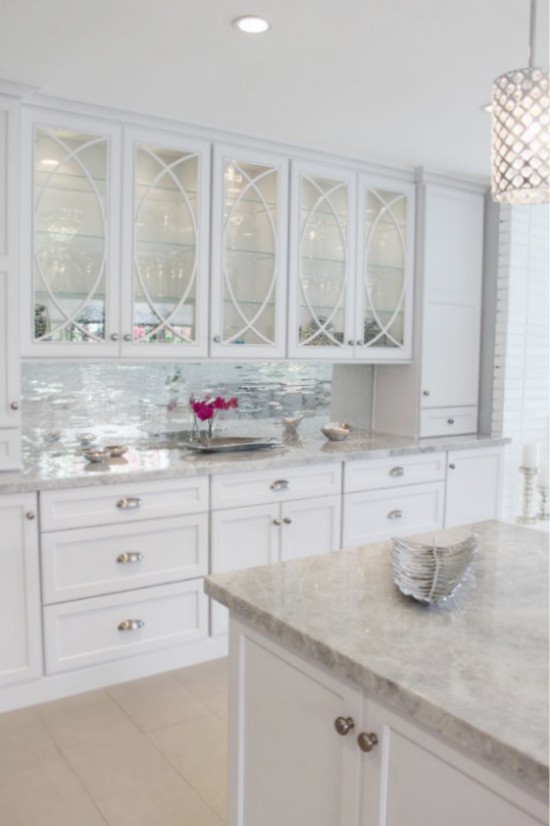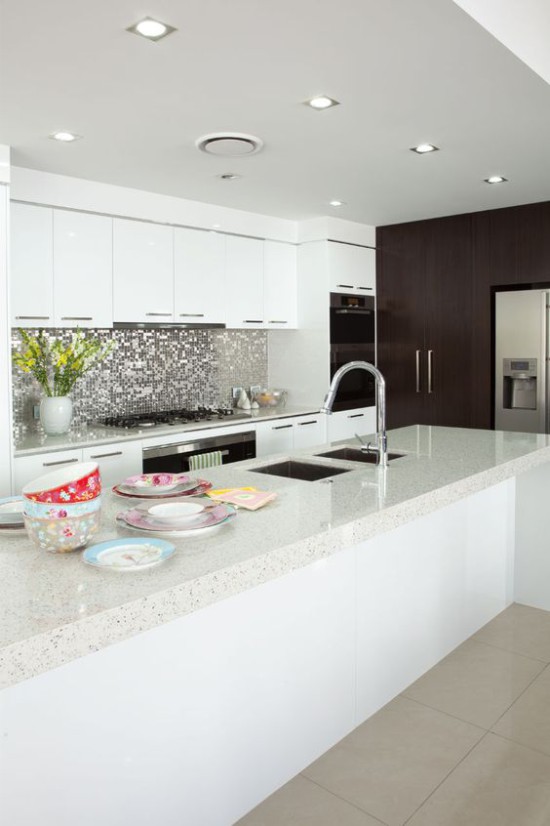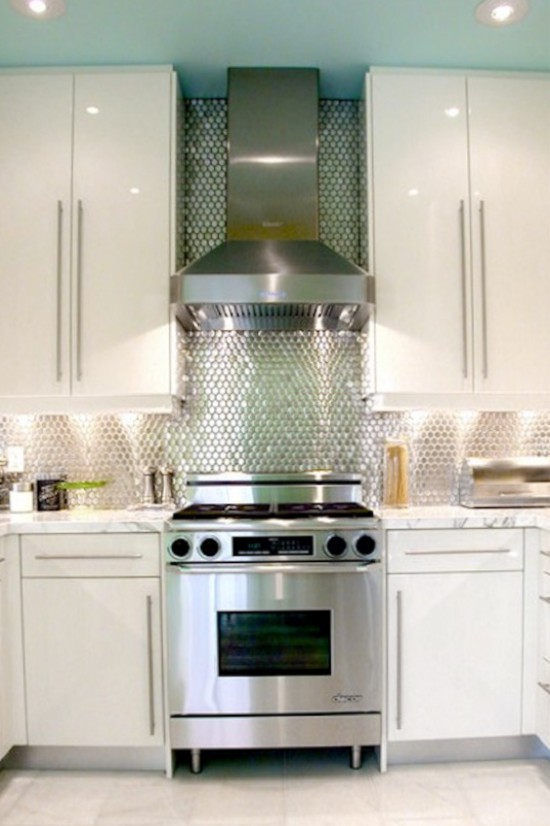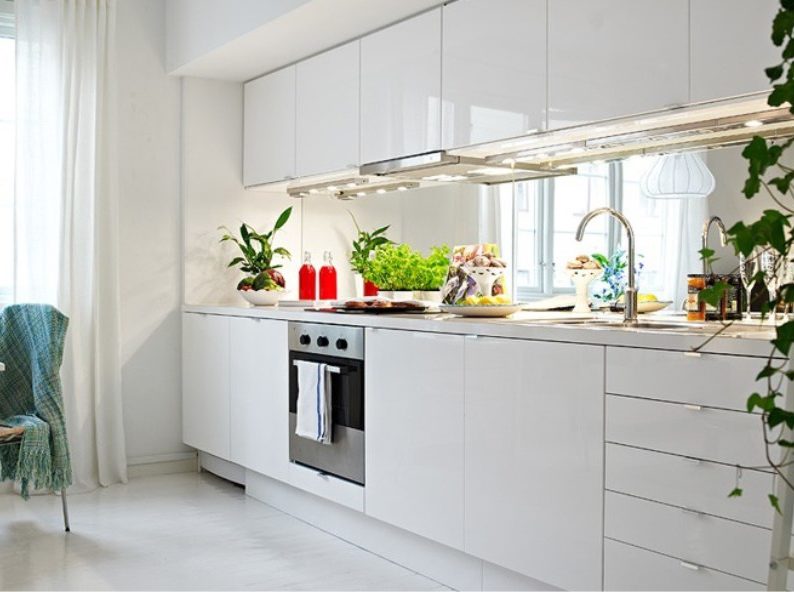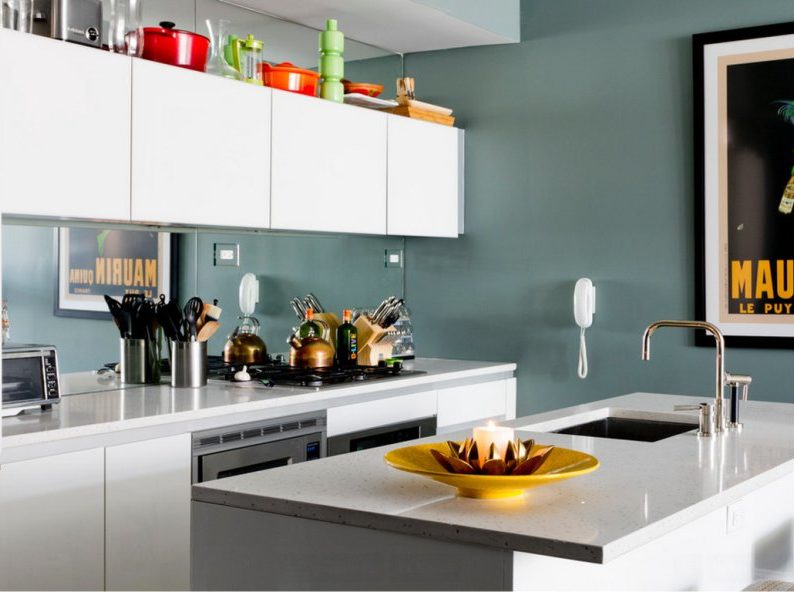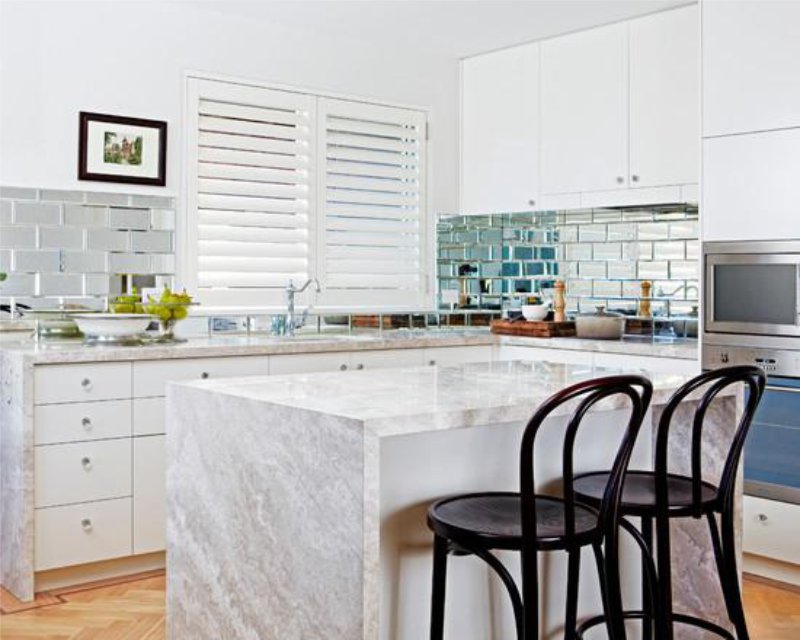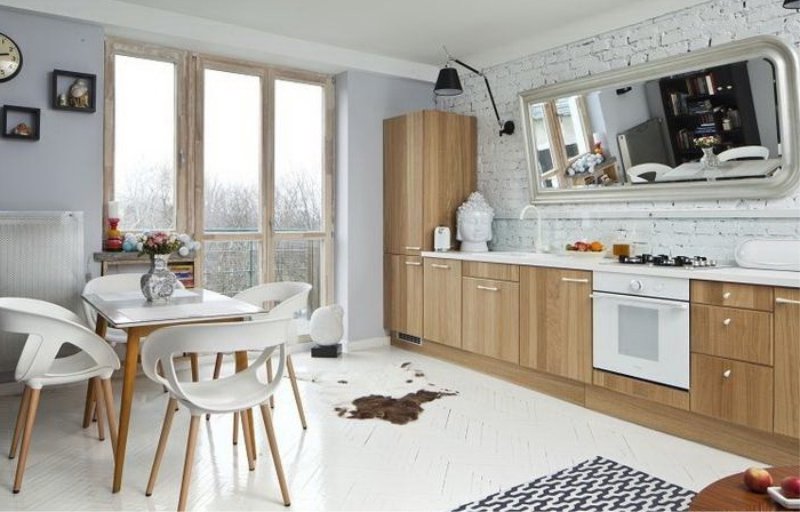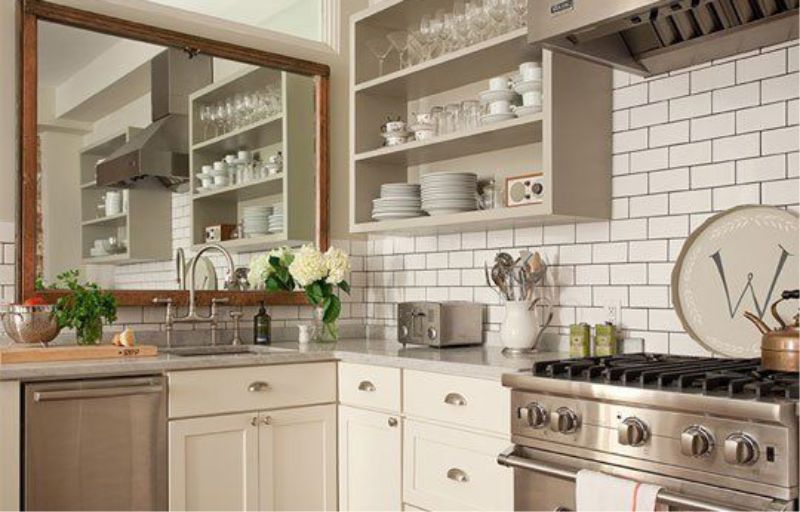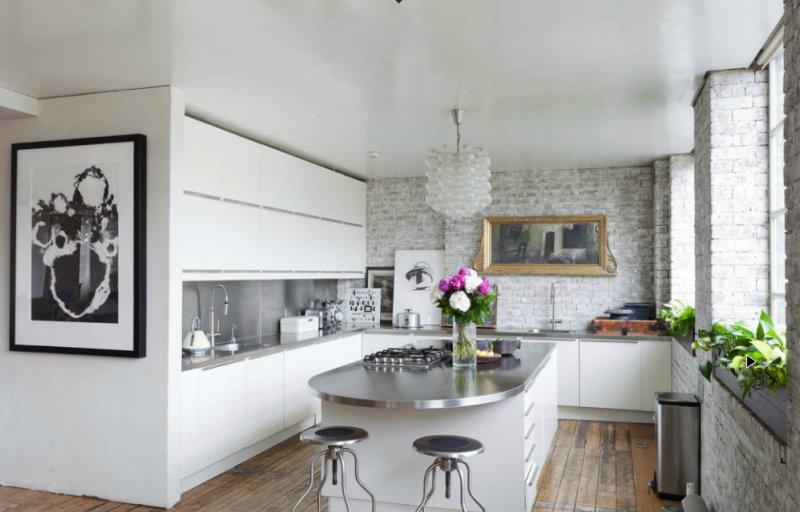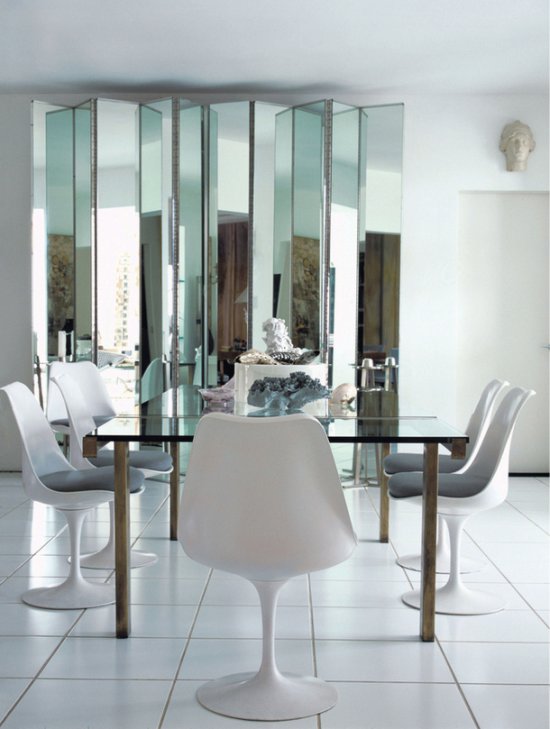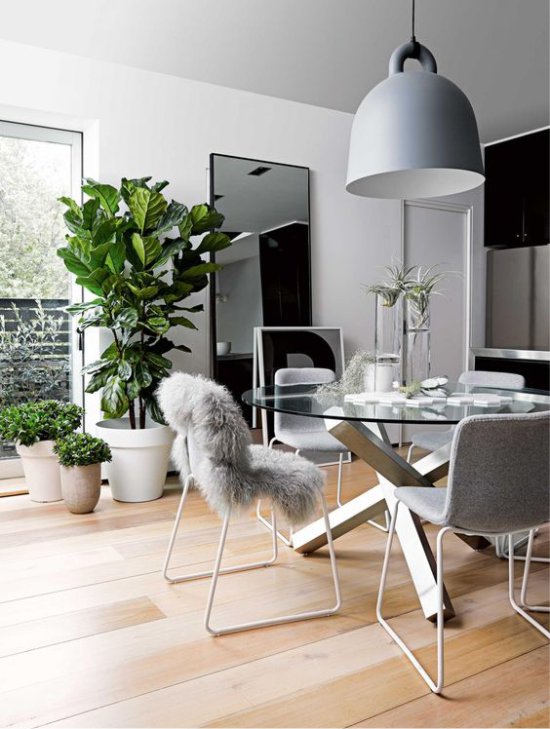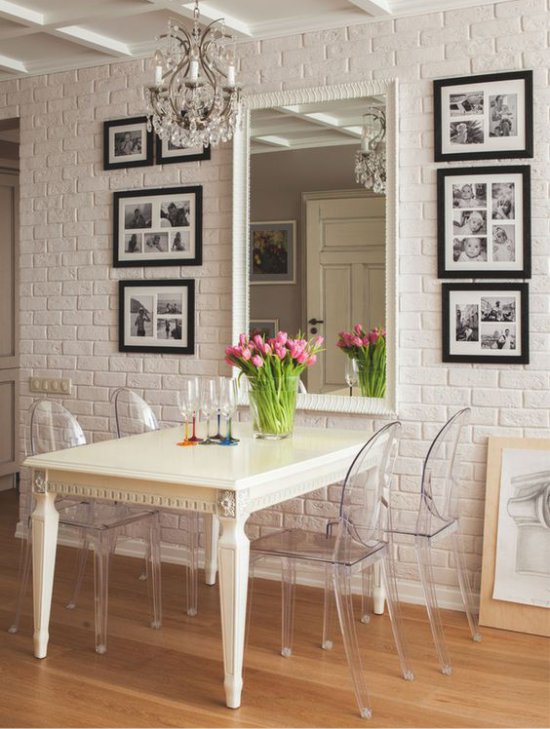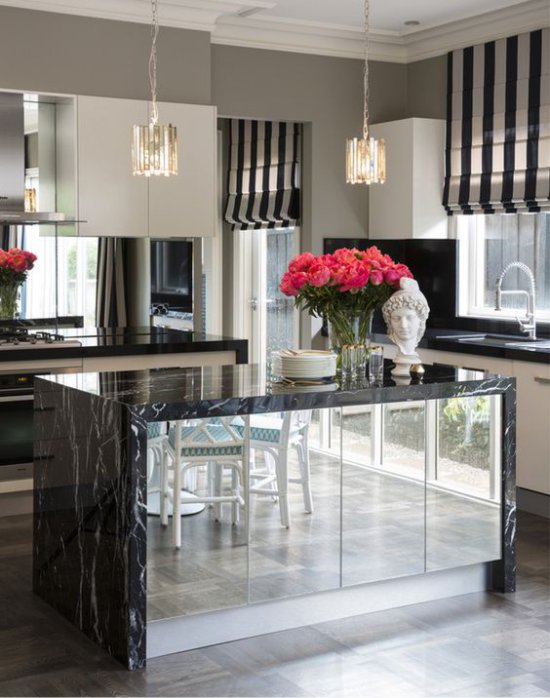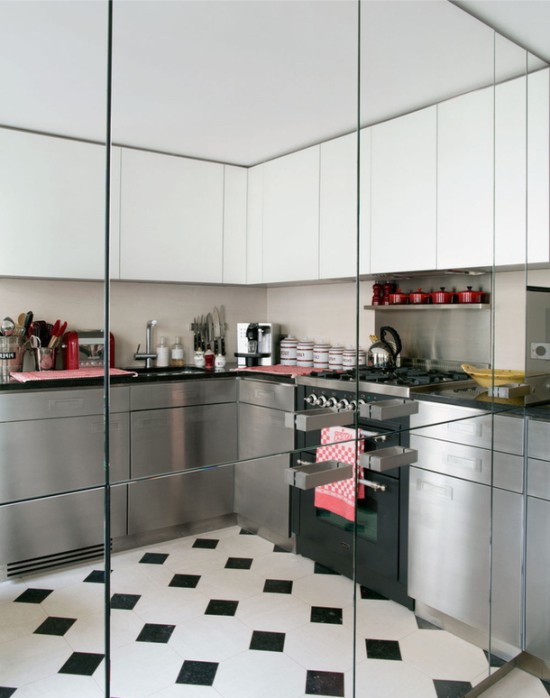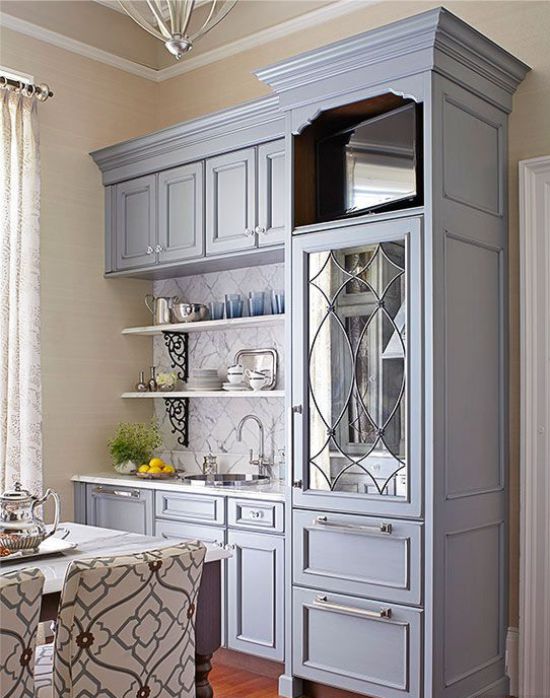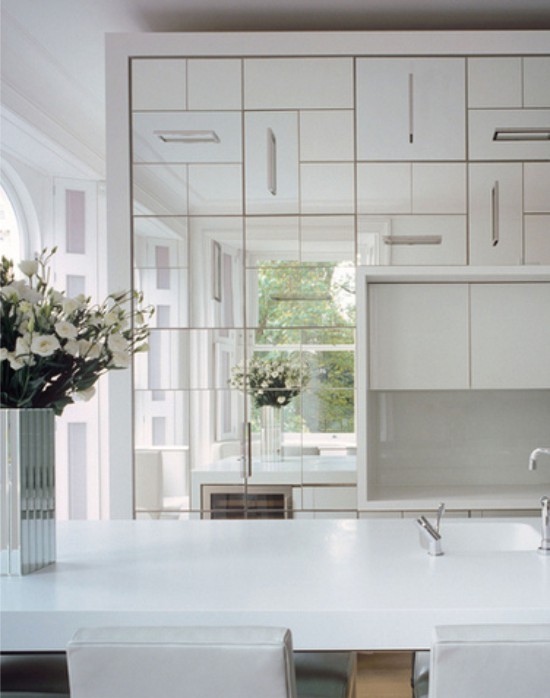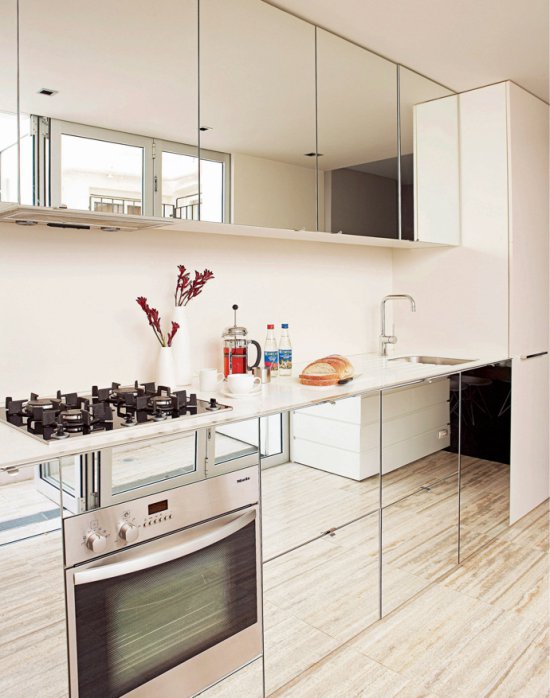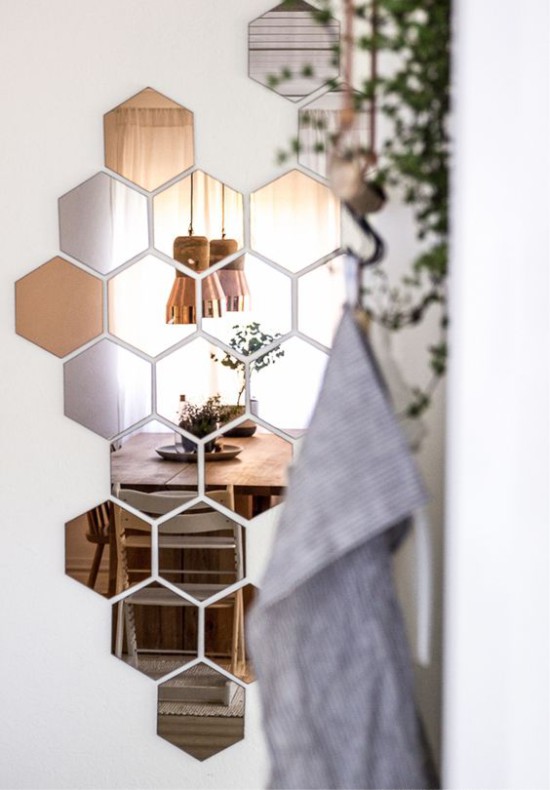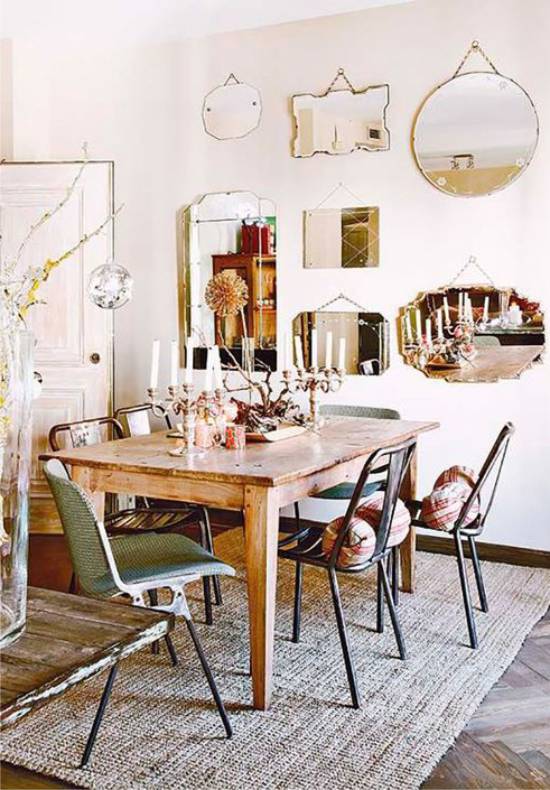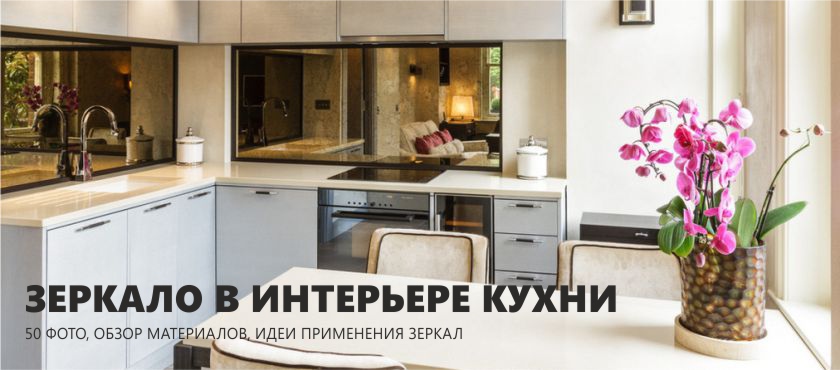
The mirror in the kitchen visually enlarges the space, enhances the lighting and simply adds a chic to the interior. Modern mirror finish can be so different in shape, color and size that you can easily find something that can decorate your kitchen. In this material we have collected a selection of 50 beautiful photos, a review of materials, tips on care and design, and also presented 7 ideas for the use of mirrors in the interior of the kitchen.
About the materials
Mirror can be made on the basis of polystyrene, acrylic or glass. Mirrors from polystyrene can not be used in the kitchen, because they are too afraid of moisture and mechanical damage. So let’s look at the last two options in more detail.
Acrylic mirror is 5 times more shock resistant, and therefore safer than glass. In addition, it is easier to install, cut and transport. The disadvantages include its lower scratch resistance and high cost.
- Since the acrylic mirror is 2 times lighter than usual, the ceilings and facades of furniture are often used to decorate them. In other cases, for example, to create a mirror apron in the kitchen, it is better to choose a traditional glass material.
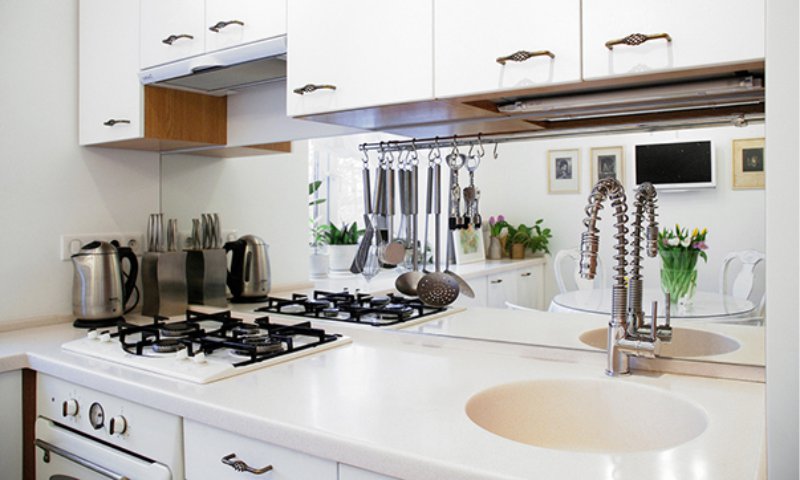
Leaf mirror in kitchen apron with skirting board
Both the acrylic and the glass mirror produce the following finishing materials:
- Sheet panels. More often, large panels cover walls, furniture facades and kitchen aprons. Sheet mirrors can have a thickness of 4 or 6 mm and are found in the following sizes (depending on the manufacturer): 255 × 160 cm, 275 × 160 cm, 321 × 225 cm, 321 × 255 cm, and 321 × 600 cm. the dimensions of the panel are adjusted during installation.
- The thicker the leaf mirror, the stronger it is, the more truthful and less exacting to the evenness of the base. Therefore, for the finishing of walls and kitchen apron, it is better to choose panels with a thickness of 6 mm. And for manufacture of wall panels, facing the ceiling, the facade of the headset or for framing in a baguette it is better to choose a mirror of 4 mm or 5 mm.
- Mosaic tiles. Most often the mirror mosaic in the kitchen is used in the cladding of an apron, walls and curved surfaces. It is sold in the form of matrices with a flexible base, but some manufacturers offer a mosaic of individual “chips”. The common sizes of chips are 2 × 2 cm and 3 × 3 cm. The mirror mosaic has many advantages. First, it is less visible spots and stains. Secondly, the mosaic is subject to local repair. Thirdly, it does not require a perfectly flat foundation. And of course, it’s just very effective and varied in design. There are at it and minuses – rather high cost and necessity periodically to clean seams. In addition, it has no reflective properties, and therefore, there will be no increase in space.
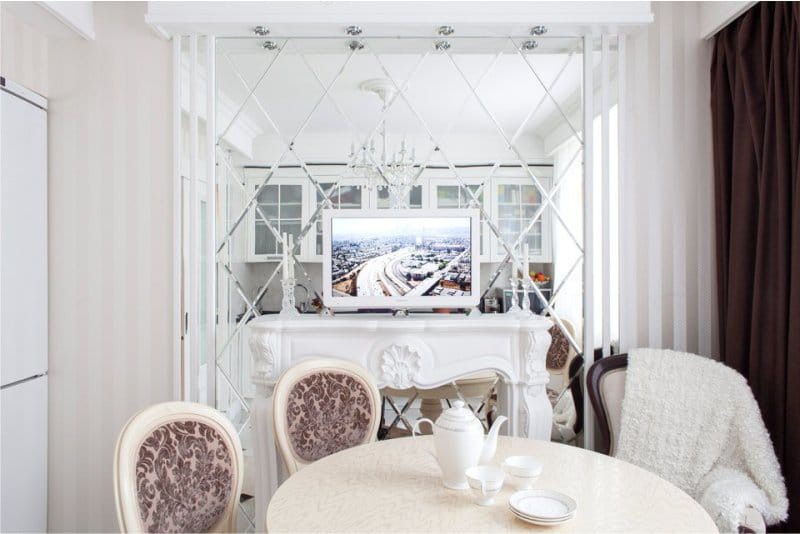
Example of decorating a dining area with a mirror tile with a facet and a backlight
- The most universal colors of the grout for the mirror mosaic are white and graphite.
- It is better and safer to choose a mosaic with a polished edge or with a facet.
- Tiles of different sizes and shapes. Produced by the type of tile “boar”, in the form of squares, triangles, hexahedrons and other geometric or fantasy forms. From such tiles you can create a mirror kitchen apron or, say, a wall panel.
About the Edge
The edge is an important part of the mirror. If the edges of the canvas are not processed in any way, then it (including amalgam) becomes more vulnerable due to microcracks and chips. Therefore, it is worth choosing mirrors with a polished edge (European edge) or with a bevel – oblique at an angle of up to 40 degrees. Mirrors with a facet are almost eternal, they shine more strongly, because they refract light.
- The width of the bevel, depending on the size and thickness of the material, can be from 4 to 45 mm.
Variations in the design of mirrors
The appearance of the mirror surface is very different. In addition to the traditional smooth silver canvas, you can choose the following varieties:
- Color mirror – colors of gold, graphite, champagne, as well as blue, green, red, pink and purple hues are achieved due to the stained-glass-base glass.
- Satin (satinate) Is a mirror, matted with chemical etching. Satin can be all the canvas or just a picture like the one shown in the photo below. Finish satinato looks like the finish of sandblasting, but looks smoother and smoother.
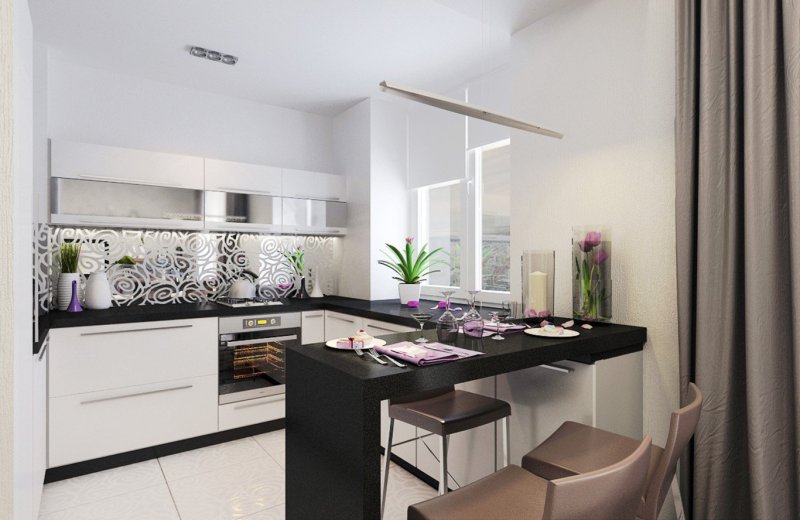
Satatinato in the kitchen apron
- Aged – the effect of a clouded surface with a detached amalgam is also achieved by chemical etching or direct printing of an amalgam layer deposited under the layer. Aged mirrors best fit in classical interiors of kitchens.

- With a picture under amalgam – The mirror can have any pattern or pattern that you want. It is applied to the film by direct UV printing, which is then glued to the glass and coated with amalgam.
- With sandblasting pattern – Using the sandblasting method, it is possible to apply a pattern from the outside of the mirror (then the effect will be frost-bitten) or with a reverse, that is, by amalgam (then the effect of the pattern inside the mirror will be obtained). An important nuance – a mirror with sandblasting must necessarily be framed. In addition, keep in mind that for the lining of the apron it does not fit, as it requires careful handling.
About installation
Mirror structures should be fixed on flat surfaces. It is especially important to prepare the walls well if you are installing a sheet mirror apron or a mirror in the wall instead of wallpaper. You can mount the material in three ways:
- On fasteners (with drilling);
- On glue or liquid nails for mirrors (without drilling);
- On hooks (concealed installation with drilling of walls).
Of the listed methods of fastening, the most reliable is glue.
About care
Is it practical to use mirrors in the kitchen? On the one hand, they are not afraid of alkalis, acids, water, soft brushes. The surface of the mirror is smooth and non-porous, so dirt and even grease spots are easily washed from it. On the other hand, mirrors oblige to frequent cleaning, because they are beautiful only in pure form. However, much here depends on their location. For example, a mirror apron is a solution either for those who are not afraid of cleaning, or for those who rarely cook. But the mirror hanging, say, in the dining area, it is enough to wipe it once a week.
- It is easiest to wipe the mirror with a microfibre cloth.
Ideas of application
- Mirror in apron
The mirror apron is good in that it allows the hostess to see what the household is doing while she is cooking, or to watch TV in the reflection of the mirror. And it also increases the space. However, keep in mind that the worktop, sink, food and dirty dishes will always “double” in reflection. In this sense, and from the point of view of practicality, it is better to choose a mirror mosaic for finishing the apron. The following compilation presents photo-examples of the application of a mirror mosaic in the kitchen.
Further in the slider there are photos of mirror aprons in the interiors of small kitchens.
And here is a selection of photo-examples of the facing of the apron with a mirror tile.
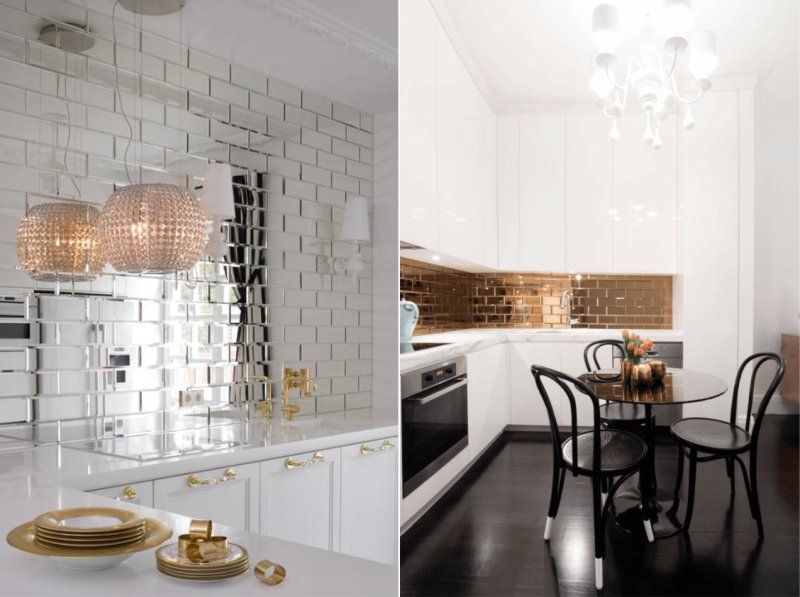
- Decorative wall mirror in the work area
If there is a spot in the working area of your kitchen, you can fill the void with a wall mirror in the frame.
- By the way, hanging a mirror in front of the window, you will make the kitchen much lighter, and if opposite the TV, you can watch your favorite programs without interruption from cooking.

- Throughout the wall
If the kitchen is small or narrow, then lining one of the walls with a mirror instead of wallpaper, you will visually increase the space almost twice. In the interior of the kitchen-dining room in the photo below the mirrors are faced with two walls and framed with moldings.

- In the dining area
If you hang a mirror opposite the dining table, then according to the teachings of feng shui, draw in the house prosperity, and according to the opinion of nutritionists – stop overeating. Designers also use this technique simply for zoning, increasing space, enhancing lighting and beauty.
- Keep in mind that the mirror should be so large that it does not cut off the heads of those sitting at the table.
And here are the photo-examples of the design of the mirror bar counter.
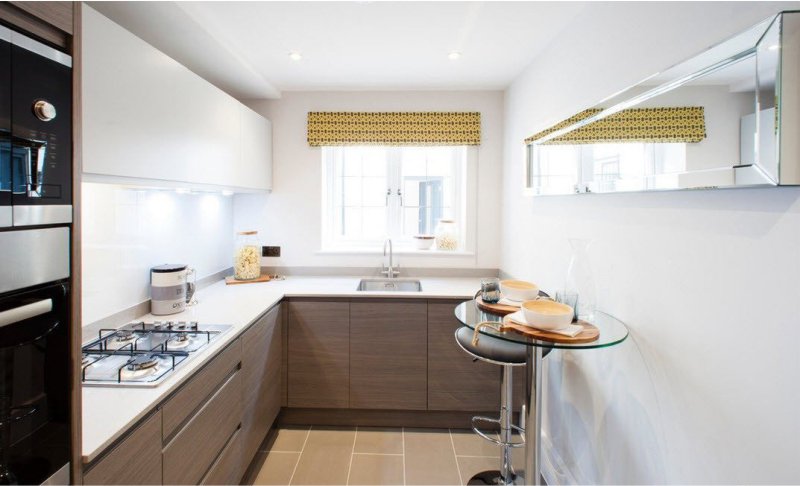
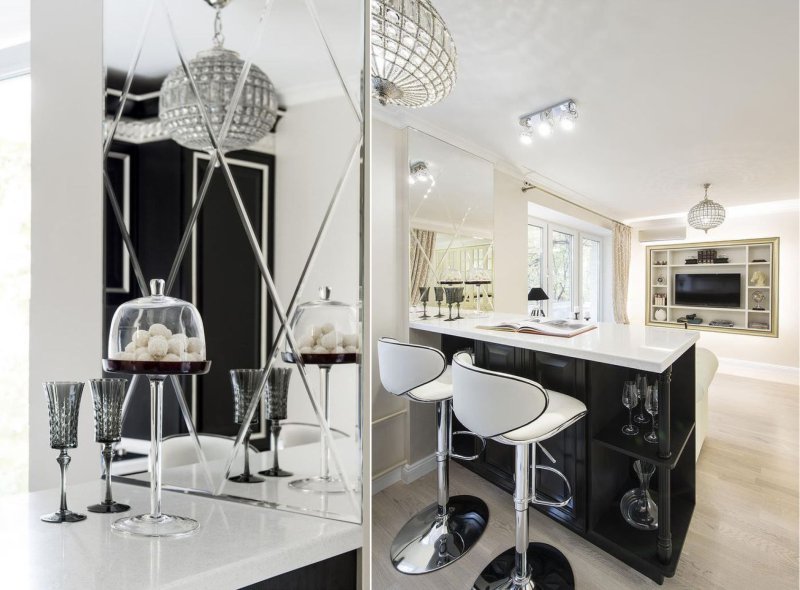
- On the facades of the headset
Kitchen with mirror facades is an idea for the most accurate owners who will open lockers just by holding the handles and often wiping the area around them. However, only part of the facades can be mirrored, then cleaning will not be so difficult. In the next photo slider, 6 examples of mirror kitchen design are presented.
- On the ceiling
Mirror ceiling in the kitchen can be created with the help of Armstrong suspended ceiling system or with mirror rails.
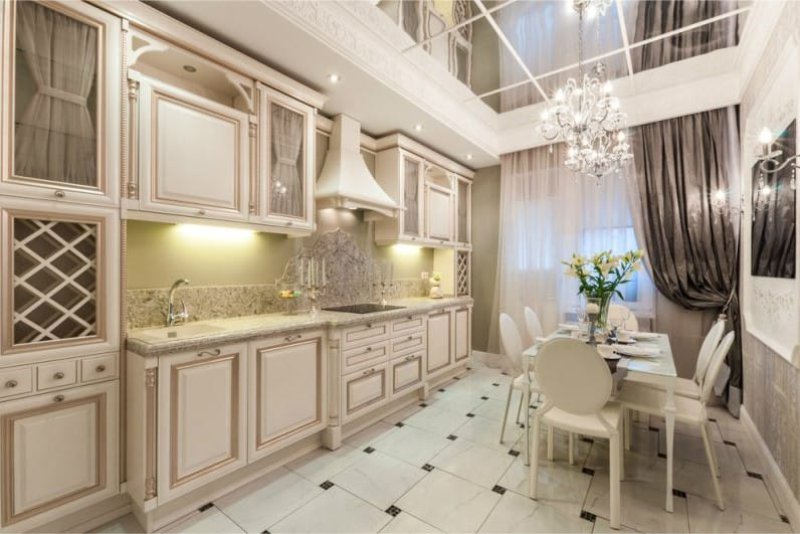
- In the form of a wall panel or a composition of wall mirrors of different sizes and shapes
From mirror tiles, mosaic or simply decorative mirrors of different shapes and sizes, you can create a beautiful wall composition with your own hands. However, mirror panels are sold and ready-made, and made to order.


